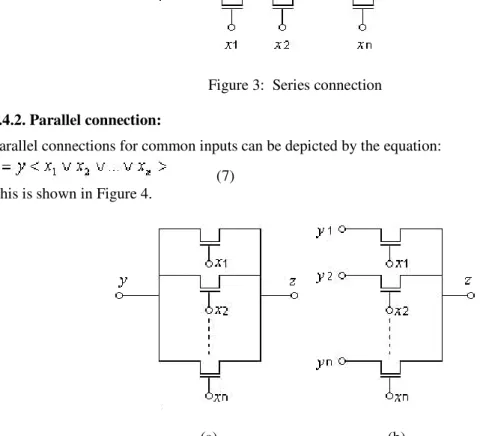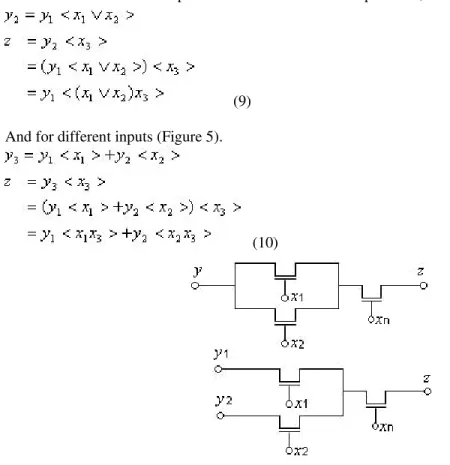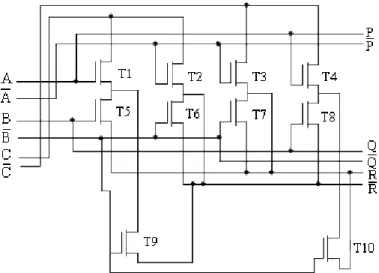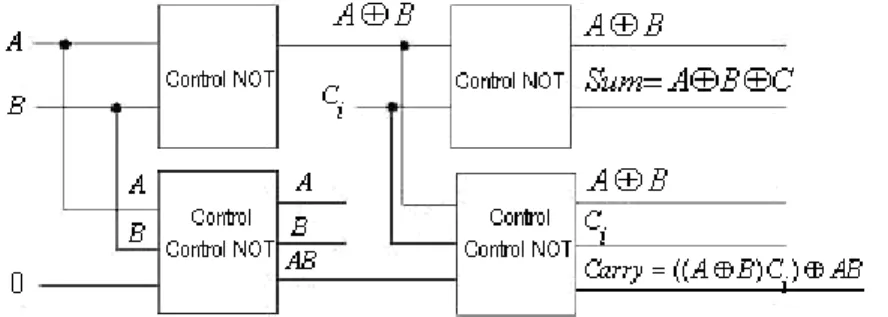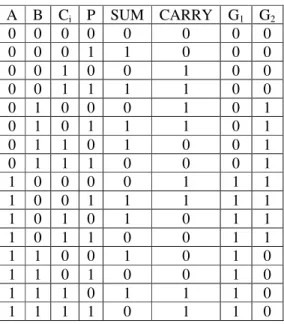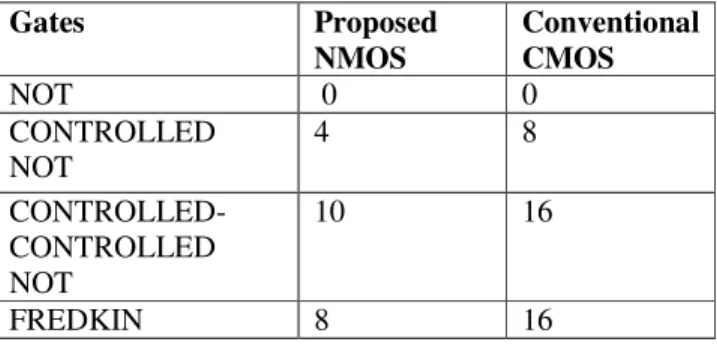Md. Sazzad Hossain
1, Md. Rashedul Hasan Rakib
1, Md. Motiur Rahman
1,
A. S. M. Delowar Hossain
1and Md. Minul Hasan21
Department of Computer Science and Engineering, Mawlana Bhashani Science & Technology University, Santosh, Tangail-1902, Bangladesh
sazzad_101@yahoo.com
2
Amader Ltd, 5B Union Erin, 9/1 North Dhanmondi, Kalabagan, Dhaka, Bangladesh.
md.minul.hasan@gmail.com
A
BSTRACTIn this paper, we have proposed a new design technique of BCD Adder using newly constructed reversible gates are based on NMOS with pass transistor gates, where the conventional reversible gates are based on CMOS with transmission gates. We also compare the proposed reversible gates with the conventional CMOS reversible gates which show that the required number of Transistors is significantly reduced.
K
EYWORDSCMOS, Feynman gates, Fredkin gate, NMOS & pass transistor.
1.
I
NTRODUCTIONIrreversible hardware computation results in energy dissipation due to information loss. According to Landauer’s research, the amount of energy dissipated for every irreversible bit operation is at least KTln2 joules, where K=1.3806505*10-23m2kgs-2K-1 (joule/kelvin) is the Boltzmann’s constant and T is the temperature at which operation is performed [1, 2]. In 1973, Bennett showed that KTln2 energy would not dissipate from a system as long as the system allows the reproduction of the inputs from observed outputs [3, 4].
Reversible logic supports the process of running the system both forward and backward. This means that reversible computations can generate inputs from outputs and can stop and go back to any point in the computation history. Thus, reversible logic circuits offer an alternative that allows computation with arbitrarily small energy dissipation. Therefore, logical reversibility is a necessary (although not sufficient) condition for physical reversibility.
There are many design techniques to implement a reversible BCD adder. The internal reversible gates of those BCD adders are used CMOS pass transistor logic [5, 6]. In this paper, we have avoided conventional CMOS based reversible gates and implement those reversible gates using NMOS based pass transistor logic. Finally, we have proposed a reversible BCD adder that poses all the good features of reversible logic synthesis using our implemented reversible gates.
attributes and general operations of pass transistor. Section four-Construction of proposed reversible gates; describes how to construct our proposed reversible gates from the conventional reversible gates. Section five and six- Design of a Reversible Full Adder and BCD adder; describes how to construct a Reversible Full Adder and BCD Adder using our proposed reversible logic gates. Section seven-Comparison; describes the performance of our proposed technique. Conclusion has been drawn in the Last Section.
2.
B
ACKGROUNDIn conventional (irreversible) circuit synthesis, one typically starts with a universal gate library and some specification of a Boolean function. It is widely known that an arbitrary Boolean function can be implemented using only NAND gates. A NAND gate has two binary inputs (say A, B) but only one binary output (say P), and therefore is logically irreversible.
2.1. Reversible Gates and Circuits
Fredkin and Toffoli have shown in [8] that a basic building block which is logically reversible should have three binary inputs (say A, B and C) and three binary outputs (say P, Q and R).
Feynman has proposed in [1], [9] the use of three fundamental gates: • The NOT gate,
• The CONTROLLED NOT gate and
• The CONTROLLED CONTROLLED NOT gate.
Together they form a set of three building blocks with which we can synthesize arbitrary logic functions.
The NOT gate can be realized, P=NOT A
The CONTROLLED NOT can be realized,
When P=A and If A=0, then Q=B else Q=NOT B So we can write Q=A XOR B
Table 1: Truth table of CONTROLLED NOT
A B P Q 0 0 0 0 0 1 0 1 1 0 1 1 1 1 1 0
The CONTROLLED CONTROLLED NOT can be realized,
When P=A, Q=B and
If A AND B=0, then R=C, Else R=NOT C
Table 2: Truth table of CONTROLLED CONTROLLED NOT
A B C P Q R 0 0 0 0 0 0 0 0 1 0 0 1 0 1 0 0 1 0 0 1 1 0 1 1 1 0 0 1 0 0 1 0 1 1 0 1 1 1 0 1 1 1 1 1 1 1 1 0
The CONTROLLED CONTROLLED NOT has a significant characteristic: it is a universal primitive which means, by combining a finite number of such building blocks, any Boolean function of any finite number of logic input variables can be implemented.
FREDKIN gate also possesses the characteristic of the CONTROLLED CONTROLLED NOT that is it is another universal primitive. It can be realized,
When P=A and If A=0, then Q=B
R=C else Q=C R=B
So we can write Q= ((NOT A) AND B) OR (A AND C) R= ((NOT A) AND C) OR (A AND B)
Table 3: Truth table of Fredkin gate
A B C P Q R 0 0 0 0 0 0 0 0 1 0 0 1 0 1 0 0 1 0 0 1 1 0 1 1 1 0 0 1 0 0 1 0 1 1 1 0 1 1 0 1 0 1 1 1 1 1 1 1
3. P
ROPERTIES OFP
ASST
RANSISTOR3.1. Pass Transistor Logic
Table 4: The truth table for pass transistor logic is as follows:
Control Signal (P1)
Input Signal (V1)
Output
0 0 High Impedance
0 1 High Impedance
1 0 0
1 1 1
Figure 1: Model for Pass transistor logic
3.2. Threshold Voltage
A pass transistor with a threshold gate is shown in Figure 2. The threshold gate is replaced by a conventional NMOS or CMOS inverter.
Figure 2: Symbol of a pass transistor and a threshold gate
If the pass transistor in figure 2 is turned on, the output is equal to the input, while if it is turned off, then the output is in a high impedance state.
The inverting voltage V
i is represented for an NMOS inverter as:
(1) and for an CMOS inverter as:
(2)
Each threshold voltage vt in MOS transistors can be fabricated by the ion-injection technology with high accuracy. Therefore, those inverters can be used as inverted threshold gates with arbitrary threshold values.
3.3. Representation of pass transistor
Figure 2 shows the symbolic representations for a pass transistor with an inverted threshold gate. The definition of the values in the inputs y
1 and y2 and the output z is given as used in [11]:
y
r , z∈ (0, 1, 2… r-1, ) (3)
The relation between y
(4)
Using the internal parameter x, the relation of the input y
1 and the output z in a pass transistor is
denoted as:
(5)
3.4. Connection of pass transistor
As described in detailed in [10] the pass transistors with threshold gates can be combined in series and/or parallel connection combinations. The equation (5) can be regarded as the basic of the representation of the inputs and outputs of connections [13].
3.4.1. Series connection:
The series connection can be depicted as:
(6) This is shown in Figure 3
Figure 3: Series connection
3.4.2. Parallel connection:
Parallel connections for common inputs can be depicted by the equation:
(7) This is shown in Figure 4.
(a) (b)
Figure 4: Parallel connectiona) Common inputs b) Different inputs
While the parallel connections for different inputs can be depicted as:
Where ‘+’ is an operator which satisfies the Commutative law, Law of absorption, Distributive law etc.
3.5. Parallel-series connection
The combinations of series-parallel connections can be depicted as, for common inputs (figure 5).
(9)
And for different inputs (Figure 5).
(10)
Figure 5: Parallel – series connection (Common Inputs and Different inputs)
4. C
ONSTRUCTION OFP
ROPOSEDR
EVERSIBLEG
ATES4.1. NOT
The construction of the reversible NOT gate does not require any transistor [1]. That is why it is the simplest form of reversible gate.
Figure 6: Reversible NOT gate
4.2. CONTROLLED NOT
Figure 7: Reversible CONTROLLED NOT gate
Now consider a set of values for control and pass signals to realize the operation of CONTROLLED NOT gate. Say, A=1, B=1 And corresponding inverted inputs are A=0, B=0 The input A controls the transistors T1 and T3 and A controls the transistors T2 and T4. For this control the T1 and T3 are ON and T2 and T4 are OFF and we get the pass signal (B,B) in the corresponding output lines P=1, P=0 and Q=0, Q=1.
Now if we consider the reverse mode of operation then control inputs will be P, P and pass signals will be Q, Q and outputs will be A, A and B, B. So if we start with the outputs of the forward mode of operation as inputs in the reverse mode we obtain the inputs of the forward mode as the outputs of the reverse mode.
4.3. CONTROLLED CONTROLLED NOT
The CONTROLLED CONTROLLED NOT reversible gate is similar in operation with respect to CONTROLLED NOT; Except that controlling of transistors occurs twice while transferring pass signal from input to output.
As the control mechanism occurs twice in this reversible gate that is why this gate is referred to as CONTROLLED CONTROLLED NOT.
4.4. FREDKIN GATE
In FREDKIN gate the control mechanism occurs only once by the control input A while transferring the pass signals B and C to the outputs P, Q and R.
Figure 9: Reversible FREDKIN gate
5. D
ESIGN OF AR
EVERSIBLEF
ULLA
DDERIf we consider a conventional Full Adder [1], the input section generally contains two inputs A and B with another input which is known as the carry in (C
i). The output section contains two
outputs Carry out (C
o) and Sum (S). For different combination of input values, the conventional
Full Adder sometimes generates the same outputs. That is why; we cannot determine the specific input values by looking at the output values. This yields that the circuit cannot be used as a reversible circuit. The solution of this problem is to make each of the output set unique, so that by judging the output we can determine the corresponding input. Thus the Adder can be operated reversibly.
To achieve this uniqueness of the output values we need to add some extra bits both in input and output section. The extra bit in the input section is Preset input (P) and the extra bits in the output section are two garbage outputs G
1 and G2 respectively. The truth table for reversible Full Adder
has shown in Table 5. The implementation of Full Adder using reversible logic is as follows:
Table 5: Truth table for reversible Full Adder
A B Ci P SUM CARRY G1 G2
0 0 0 0 0 0 0 0
0 0 0 1 1 0 0 0
0 0 1 0 0 1 0 0
0 0 1 1 1 1 0 0
0 1 0 0 0 1 0 1
0 1 0 1 1 1 0 1
0 1 1 0 1 0 0 1
0 1 1 1 0 0 0 1
1 0 0 0 0 1 1 1
1 0 0 1 1 1 1 1
1 0 1 0 1 0 1 1
1 0 1 1 0 0 1 1
1 1 0 0 1 0 1 0
1 1 0 1 0 0 1 0
1 1 1 0 1 1 1 0
1 1 1 1 0 1 1 0
It can be easily verified from the above table that it fulfils two conditions: (a) all sixteen outputs (C
oSG1G2) are different, such that the table is reversible, and (b) if P=0, than the output column
C
o and S have the values of a conventional Full Adder. The outputs (CoSG1G2) contain the same
amount of information as the inputs (ABC
iP), such that backward calculation is possible.
The construction of the reversible Full Adder consists of our proposed CONTROLED NOT and CONTROLED -CONTROLED NOT reversible logic gates.
6. P
ROPOSEDBCD
A
DDERU
SINGR
EVERSIBLEF
ULLA
DDERFor Designing a BCD adder we need to Design a reversible circuit for the expression C3 + S3 (S1 + S2). Where C3 denotes the carry out of the top reversible adder and S3, S2 and S1 is the sum bits of the top adder shown in figure 12. For the above expression we design a new reversible gate using pass transistor logic for calculating OR operation shown in Table 6. We have said this gate as New Proposed Gate (NPG). The logic for this gate can be realized:
When P=A and If A=1 then Q = A Else Q = B
So we can write Q = A + B
The truth table for this proposed gate is as follows:
Table 6: Truth table for new reversible Gate
A B P Q 0 0 0 0 0 1 0 1 1 0 1 1 1 1 1 1
Figure. 11 New Proposed Reversible gate
Figure. 12 BCD adder circuit using reversible gates
6. C
OMPARISONTable 7: No. of transistors used in proposed NMOS and Conventional CMOS based reversible gates
Gates Proposed
NMOS
Conventional CMOS
NOT 0 0
CONTROLLED NOT
4 8
CONTROLLED- CONTROLLED NOT
10 16
FREDKIN 8 16
Using the conventional CMOS reversible transmission gates, the construction of the circuit described in figure 10 will require 2 x 8 + 2 x 16 = 48 transistors. Meanwhile, the construction of the same circuit using the proposed reversible gates will require 2 x 4 + 2 x 10 = 28 transistors. So our proposed design significantly reduces the number of transistors in the circuit. Our proposed BCD adder requires 2 x 28 + 10 + 4 x 2 = 74, which is approximately 50% less than the conventional reversible BCD adder.
7. C
ONCLUSIONSIn this paper an optimized reversible BCD adder is presented using our proposed reversible gates. The design is very useful for the future computing techniques like low power digital circuits and quantum computers. We have constructed the NMOS based reversible gates. It uses fewer transistors then conventional CMOS based reversible gates. This yields that the amount of space of the circuitry is reduced, as well as the gates operate with low power dissipation. The time of operation should also decrease i.e. the circuit will work much faster. An important characteristic of the circuit is that all energy supplied to the system is delivered by the input signals themselves. The design method is definitely useful for the construction of future computer and other computational structures. The proposed technique can be enhanced in future by testing this proposed design in various simulators and in real world application circuits.
R
EFERENCES[1] Yvan Van Rentergem and Alexix De Vos, (2005) “Optimal design of a reversible full adder” Int. Journ. Of Unconventional Computing, Vol. 1, pp. 339-355.
[2] Landauer R., (1961) “Irreversibility and heat generation in the computing process”. IBM J. Research and Development, 5(3): 183-191.
[3] Parhami B., (2006) “Fault tolerant reversible circuits”. Proc. 40th Asilomar Conf. Signals, Systems, and Computers, October, Pacific Grove, CA.
[4] Bennett C. H., (1973) “Logical reversibility of computation”. IBM J. Research and Development, 17: 525-532.
[5] H.R.Bhagyalakshmi, M.K.Venkatesha, (2010) “Optimized reversible BCD adder using new reversible logic gates”, JOURNAL OF COMPUTING, VOLUME 2, ISSUE 2, ISSN 2151-9617 HTTPS://SITES.GOOGLE.COM/SITE/JOURNALOFCOMPUTING/
[6] X. Susan Christina, M.Sangeetha Justine, K.Rekha, U.Subha and R.Sumathi, (2010) “Realization of BCD adder using Reversible Logic”, International Journal of Computer Theory and Engineering, Vol. 2, No. 3, 1793-8201
[8] Fredkin E. and T. Toffoli, (1982) “Conservative logic”. Int’l J. Theoretical Physics, 21: 219-253. [9] R. Feynman, (1985) “Quantum Mechanical Computers”, Optics News, 11, pp. 11-20.
[10] DAMU RADHAKRISHNAN, STERLING R. WHITAKER, and GARY K. MAKI, (1985) “Formal Design Procedures for Pass Transistor Switching Circuits”, IEEE JOURNAL OF SOLID-STATE CIRCUITS, VOL. SC-20, NO.2.
[11] D. Markovic, B. Nikolic and V.G. Oklobdzija, (2000) “A general method in synthesis of pass-transistor circuits”, Microelectronics Journal 31 991-998.
[12] Okihiko Ishuzuka, (1986) “Synthesis of a Pass Transistor Network Applied to Multi-Valued Logic”, IEEE Trans.
[13] Hafiz Md. Hasan Babu, Moinul Islam Zaber, Md. Mazder Rahman and Md. Rafiquil Islam, “Implementation of Multiple-Valued Flip-Flips Using Pass Transistor Logic”, Proceedings of the EUROMICRO Systems on Digital System Design (DSD’04).
Authors
Md. Sazzad Hossain received his B.Sc. (Engg.) in Computer Science & Engineering from Mawlana Bhashani Science and Technology University, Bangladesh, in 2008. Now he is a faculty member of CSE department of that university.
Md. Rashedul Hasan Rakib received his B.Sc. (Engg.) in Computer Science & Engineering from Khulna University, Bangladesh, in 2008. Now he is a faculty member of CSE department of Mawlana Bhashani Science and Technology University, Bangladesh
Md. Motiur Rahman received his B.Sc. (Engg.) and M.Sc. (Engg.) in Computer Science & Engineering from Jahangirnagar University, Bangladesh. Now he is a faculty member of CSE department of Mawlana Bhashani Science and Technology University, Bangladesh
A. S. M. Delowar Hossain received his B.Sc. (Engg.) in Computer Science & Engineering from Islamic University of Technology, Bangladesh, in 2008. Now he is a faculty member of CSE department of Mawlana Bhashani Science and Technology University, Bangladesh.

